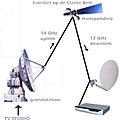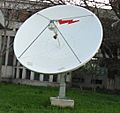Direct-broadcast satellite facts for kids
Direct broadcast satellite (DBS) is a way to send satellite television signals right to your home.
Satellite television lets you watch TV shows by sending them from a special communications satellite orbiting Earth. This signal goes directly to your house. You need an outdoor dish, called a satellite dish, and a special device called a low-noise block downconverter (LNB) to catch the signals.
A satellite receiver then decodes the TV show so you can watch it on your television set. These receivers can be a separate box or built right into your TV. Satellite TV offers many channels and services. It's often the only TV option in faraway places where regular terrestrial television (broadcast from towers) or cable television isn't available.
Modern satellite TV systems use signals sent from a communications satellite. These signals are on the Ku band frequencies (12–18 GHz). This means you only need a small dish, less than a meter (about 3 feet) wide.
Contents
How Satellite TV Works
Satellite television works by sending signals from space to your home. First, TV channels send their programs to a large antenna on Earth. This antenna beams the programs up to a satellite orbiting our planet.
The satellite then sends these signals back down to Earth. Your satellite dish catches these signals. The LNB on your dish helps to convert the signals into a format your receiver can understand.
Finally, your satellite receiver decodes the signal. It turns it into the pictures and sounds you see on your TV screen. This whole process happens very quickly, so you can watch live TV.
Old vs. New Satellite Systems
The first satellite TV systems were older types. They are now called television receive-only (TVRO) systems. These systems picked up weaker analog signals. They used the C-band (4–8 GHz) from FSS satellites.
Because of this, they needed very large dishes, usually 2 to 3 meters (6 to 10 feet) across. People often called them "big dish" systems. They were also more expensive and not as popular as today's systems.
Modern systems use much stronger digital signals. These digital signals allow for better picture quality. They also support high-definition television (HDTV). This is why modern dishes can be much smaller.
Free TV vs. Pay TV
Early satellite systems used analog signals. But today's systems use digital signals. You need different receivers for analog and digital signals.
Some satellite TV channels are unencrypted. This means they are free-to-air or free-to-view. You don't need to pay extra to watch them.
However, many other channels are encrypted. These are called pay television channels. To watch them, you need to subscribe to a service. You also pay a monthly fee to get the programming.
Images for kids
See also
 In Spanish: Televisión por satélite para niños
In Spanish: Televisión por satélite para niños





